منتجات عالية الجودة تؤدي إلى تجربة إيجابية للعملاء ، ولكن إنشاء مبيعات فعالة و استراتيجية العمليات تتجاوز مجرد السؤال عما يريده العميل. تعاون الإدارة والإيجابية ديناميكيات الفريق لا تقل أهمية لنجاح المبيعات والنمو.
يمكن لعملية تخطيط المبيعات والعمليات (S&OP) الفعالة أن تغير قواعد اللعبة في هذا الصدد - فهي تعمل على مواءمة العرض والطلب والتخطيط المالي، مما يتيح لك وضع خطة إنتاج فعالة. بالإضافة إلى ذلك، فهي تساعدك على الحفاظ على علاقات داعمة بين الإدارات من خلال تشجيع التعاون متعدد الوظائف .
في هذه المقالة، سوف نتعمق في هذه المقالة في عملية تخطيط المبيعات والعمليات من خلال استكشاف فوائدها وعيوبها المحتملة وأفضل الممارسات لمساعدتك على تنفيذها بسلاسة. سنعرفك أيضًا على الخطوات الرئيسية لعملية تنفيذ تخطيط المبيعات والعمليات ونكشف لك عن المقاييس التي يجب عليك تتبعها لدفع عجلة النمو. 📈
ما هو تخطيط المبيعات والعمليات (S&OP)؟
تخطيط المبيعات والعمليات (S&OP) هو عملية تخطيط متكاملة ومتعددة الوظائف لسلسلة التوريد التي تقوم بمواءمة عرض المنتجات والطلب عليها مع الخطة المالية للشركة من خلال مقارنة الطلب المتوقع بالموارد المتاحة. تساعد المفاضلة المقدمة المديرين التنفيذيين في اتخاذ القرارات الاستراتيجية في أمور مثل
- تحقيق التوازن بين الطلب والعرض
- تقديم منتجات جديدة وإيقاف المنتجات القديمة
- ضمانمؤشرات الأداء الرئيسية للمبيعات استيفاء مؤشرات الأداء الرئيسية للمبيعات
- تعديل خطط تنفيذ عمليات تخطيط المبيعات والعمليات
العملية يمكن أن تكون تُجرى شهريًا أو سنويًا أو كل سنتين أو ثلاث سنوات، اعتمادًا على أهداف الشركة .
يعتمد نجاح عملية تخطيط المبيعات والعمليات على التعاون القوي ومزامنة أقسام تطوير المنتجات والتصنيع والتسويق والمبيعات والمالية. إن مدخلات جميع الفرق ذات الصلة هي الطريقة الوحيدة للحصول على خطة تخطيط المبيعات والعمليات المتينة والفعالة، والتي تعزز أيضًا العمل الجماعي والتفاني في تحقيق نفس الهدف.
هل أنت متحمس للبدء؟ ابدأ عملية تخطيط المبيعات والعمليات الخاصة بك مع نموذج خطة مبيعات ClickUp ! تتبع بسهولة التقدم المحرز في خطتك والإنجازات المصاحبة لها من خلال عرض القائمة أو الجدول الزمني أو مخطط جانت، وشارك القالب عبر الأقسام لإبقاء الجميع على اطلاع. 🔄
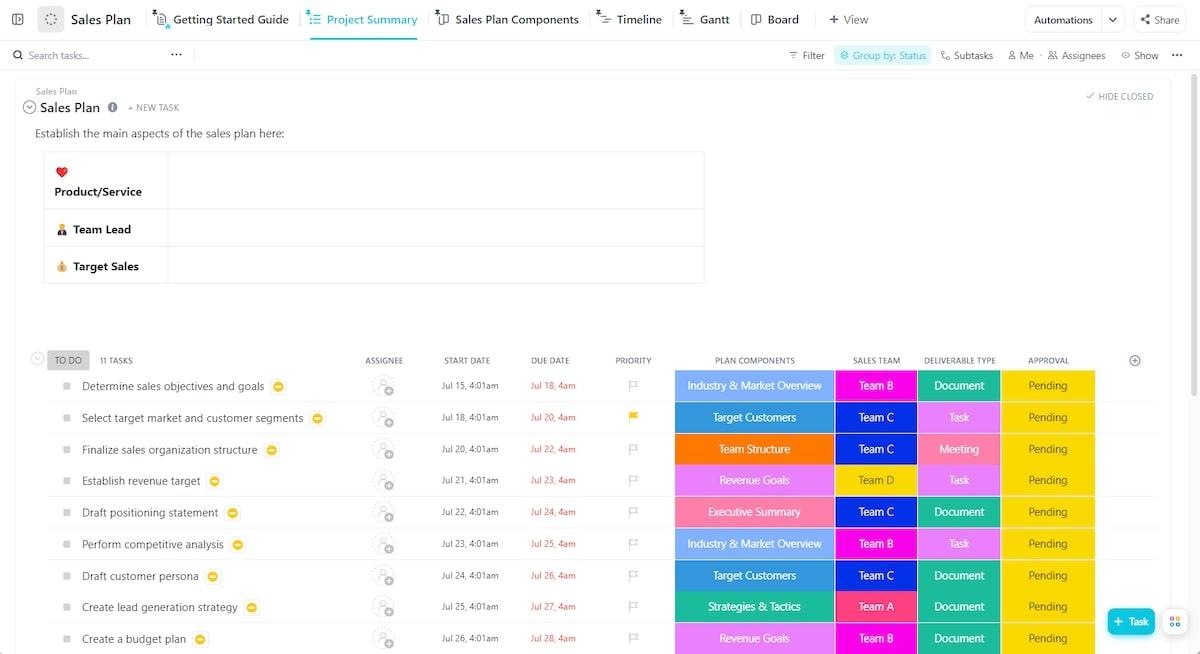
يمكنك إنشاء خطة مبيعات وتتبع المهام بسهولة باستخدام الحقول المخصصة في قالب خطة مبيعات ClickUp
فوائد عملية S&OP
يمكن أن يساعد تنفيذ عملية تخطيط المبيعات والعمليات فرق المبيعات والعمليات لديك بطرق عديدة. فبادئ ذي بدء، تعمل هذه العملية على تبسيط عمليات المبيعات والعمليات وتقليل تكاليف الإنتاج، ولكن فوائدها تتجاوز ذلك. فيما يلي تفصيل ل أهم مزايا عملية تخطيط المبيعات والعمليات.
تعاون أقوى
تعتمد عملية تخطيط المبيعات والعمليات الناجحة بقوة على التعاون متعدد الوظائف من أجل اتخاذ قرارات أفضل . تعد المدخلات من الفرق ذات الصلة ضرورية لتصميم خطة S&OP لأن بياناتهم هي التي تساعد القيادة على وضع خطة فعالة في المقام الأول.
يشجع التعاون القوي الفريق على النظر إلى الصورة الأكبر - الإنتاجية الإجمالية للشركة ونموها - بدلاً من النظر إلى أهداف أقسامهم فقط. يتيح ذلك للفرق مشاركة الأفكار والمعلومات عبر الأقسام المختلفة، مما يضمن إطلاع الجميع على الاتجاهات الحالية والتحديات القادمة، وهو أمر بالغ الأهمية لنجاح الخطة.
تحسين إدارة المخزون
تطابق نظام تخطيط العمليات والمبيعات بين العرض والطلب لضمان وجود عدم وجود مخزون زائد لذلك سوف تتجنب خسارة الإيرادات الناجمة عن نفاد المخزون أو تكاليف مخزون المستودعات.
ابدأ إدارة المخزون الخاص بك مع قالب إدارة المخزون ClickUp ! راجع البيانات التاريخية لاتجاهات السوق والتنبؤ، واضبط مستويات المخزون بناءً على المبيعات، واحصل على رؤية واضحة للعمليات اليومية باستخدام عرضي الجدول الزمني والقائمة في القالب.

تتبع أداء المخزون في الوقت الفعلي باستخدام قالب إدارة المخزون ClickUp Inventory Management (نموذج إدارة المخزون ClickUp)
خدمة العملاء المحسنة
يساعدك تخطيط S&OP في تقديم منتجات تلبي طلب العملاء في الوقت المحدد. كما يساعدك أيضًا على تسعير منتجك بشكل صحيح من خلال توفير رؤى عميقة حول التوازن بين العرض والطلب.
ربحية أعلى
تساعدك عمليات S&OP الفعالة على التنبؤ بالطلب على المنتج بشكل أفضل ووضع خطة وفقًا لذلك. مع زيادة الوعي باحتياجات سلسلة التوريد، يمكنك الاستجابة لطلبات العملاء بسرعة. وهذا يمنع العملاء من انتظار منتجاتك أو خدماتك، مما قد يدفعهم إلى المنافسين. بالإضافة إلى أنه يساعدك على تقليل تكاليف الإنتاج الزائد. 💰
استجابة أسرع للأزمات
يساعد تخطيط السيناريوهات في عمليات تخطيط S&OP في الاستجابة السريعة للتغيرات في العرض والطلب. يساعد وجود خطط لسيناريوهات مختلفة الشركات في إعداد حلول بديلة للمشكلات المحتملة مسبقًا حتى لا تفوت فرص الإيرادات أو تفقد العملاء.
تحديات عملية تخطيط S&OP
والآن، دعنا الآن نستكشف التحديات الرئيسية التي قد تواجهها في عملية تخطيط S&OP ونرى كيف يمكنك التغلب عليها بفعالية.
تنفيذ العملية
قد تبدو عملية تخطيط S&OP معقدة لأنها تتضمن العديد من المتغيرات التي يجب أن تسير بسلاسة لضمان نجاح إدارة سلسلة التوريد. قد يجعل تعقيد العملية من الصعب فهمها ويمكن أن يؤدي إلى حدوث ارتباك بين أصحاب المصلحة.
للتغلب على هذا التحدي، احرص على مخططات تدفق العمليات مباشرة ونظيفة. استخدام حل لإدارة المشاريع مثل انقر فوق طريقة رائعة لإنشاء مخططات انسيابية تعاونية بسهولة. قم بإنشاء مخطط انسيابي مثالي لعملية تخطيط S&OP الخاصة بك باستخدام قالب مخطط تدفق العمليات ClickUp -إطار عمل مصمم مسبقًا وقابل للتخصيص بالكامل، وهو مثالي إذا كنت ترغب في بدء العمل في أسرع وقت ممكن! 🏃
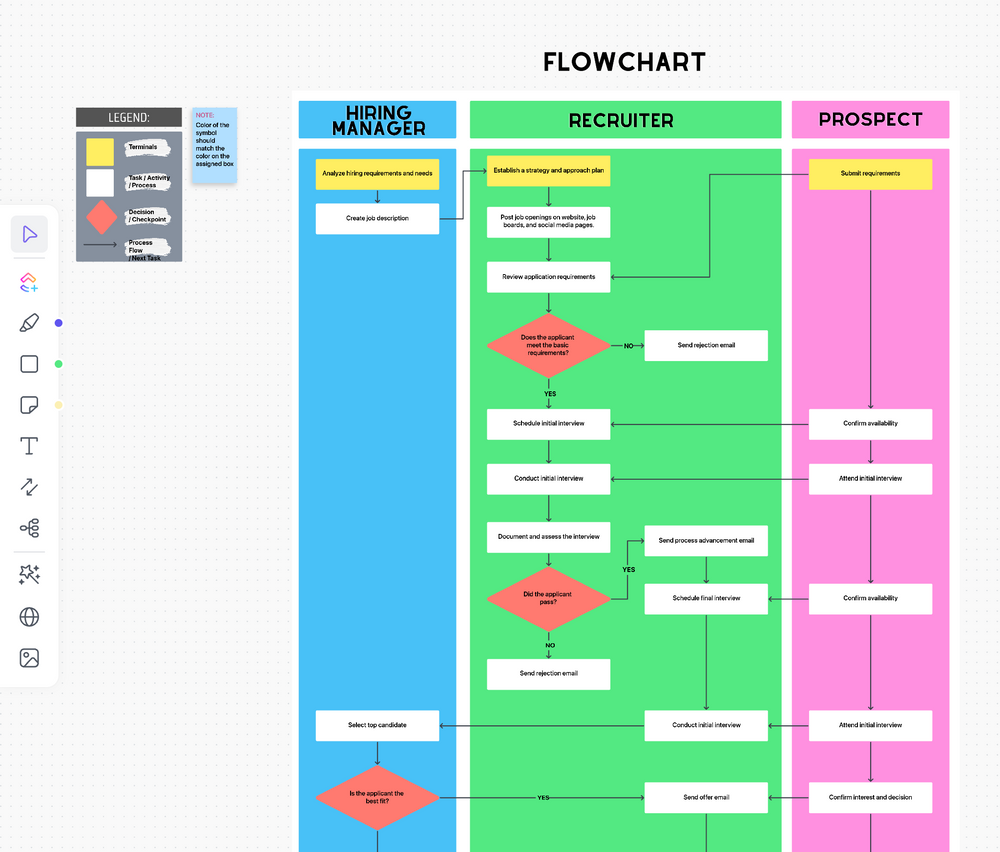
يتيح لك قالب مخطط تدفق العمليات ClickUp تصميم عملياتك وإدارتها وتصورها بسهولة
توظيف المواهب المناسبة
يتطلب توظيف مشغلي سلسلة التوريد دراسة متأنية حيث ستحتاج إلى موظفين يتمتعون بمهارات تقنية وتحليلية قوية. كما يجب أن يكون الأشخاص الذين تقوم بتعيينهم على دراية بجميع عمليات سلسلة التوريد من أجل ضمان التعاون السلس .
يمكن أن يستغرق اختيار المرشح المناسب وقتًا طويلاً، لذا قم بتبسيطه باستخدام نموذج ClickUp لتوظيف المرشحين ، والذي يتيح لك مراجعة المرشحين ومقارنتهم وتحديد أولوياتهم للعثور على المرشح المثالي لفريق S&OP لديك. 👌
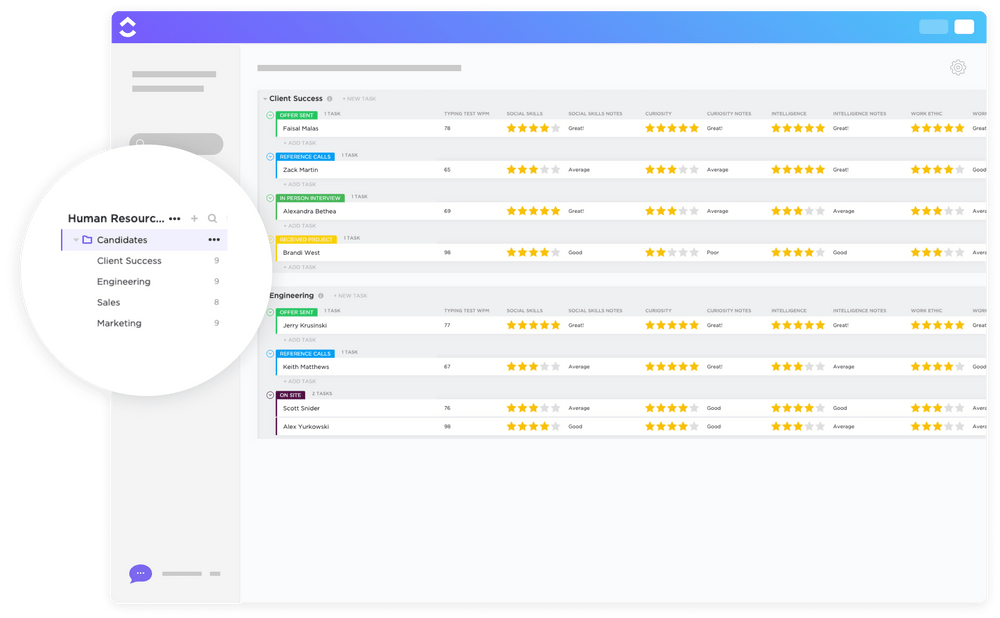
استخدم قالب ClickUp لتوظيف المرشحين لتتبع عملية التوظيف وإدارتها بكفاءة
الحفاظ على الشفافية عبر الأقسام
يتطلب تخطيط S&OP أن تعمل أقسام متعددة معًا لمواءمة خطط العرض والطلب لديك. وهذا يعني أنه يجب أن تكون أقسام المبيعات والتسويق والخدمات اللوجستية والتصنيع والشؤون المالية لديك على علم دائم بالتغييرات والتحديثات في العملية. ومع ذلك، قد يكون التحقق من أنشطة العديد من الأقسام أمرًا صعبًا.
يمكنك التغلب على هذا التحدي من خلال ترقيم جميع مستنداتك والاحتفاظ بها في موقع مركزي. بهذه الطريقة، يمكن لجميع الأقسام الوصول إليها لعرض التحديثات أو الأخبار أو التغييرات أو أي معلومات مهمة أخرى.
ابدأ تشغيل قاعدة البيانات الخاصة بك دون عناء إنشاء مستند من الصفر باستخدام قالب ClickUp Wiki ! قم بتوثيق أي شيء تحتاجه في صفحات وأقسام القالب المعدة مسبقًا، وقم بتخصيصها لتناسب احتياجات عملك. 📝

استفد من الصفحات المحملة مسبقًا في قالب ClickUp Wiki Template للحفاظ على مركزية جميع معلومات شركتك
كيف تنشئ عملية ناجحة لتخطيط المبيعات والتشغيل
تتطلب عملية تخطيط المبيعات والعمليات الناجحة ست خطوات بسيطة يجب تنفيذها بترتيب ثابت. دعنا نتعمق في كل خطوة لنرى ما تستلزمه هذه الخطوات!
الخطوة 1: جمع البيانات
تُعد خطوة جمع البيانات أساس عملية تخطيط المبيعات والإنتاج، حيث إنها تساعد المؤسسات على تطوير خطة عمل واقعية . تتضمن جمع البيانات المتعلقة بـ
- توقعات المبيعات
- المبيعات التاريخية
- ظروف السوق ذات الصلة
- معدل نجاح خطط التسويق السابقة
- أهداف الإنتاج والمخزون
الهدف الرئيسي من جمع البيانات هو إنشاء توقعات للمبيعات المستقبلية من خلال اكتساب رؤية عميقة للوضع الحالي للشركة والطلب المستقبلي المحتمل.
الخطوة 2: تخطيط الطلب
تخطيط الطلب هو أهم خطوة في عملية تخطيط S&OP. ويتطلب تحليل اتجاهات المستهلكين وتوقعات المبيعات والبيانات التاريخية لإنشاء خطة طلب تخبرك بعدد الوحدات التي يمكن بيعها من المنتج ومتى وأين يمكن تلبية الطلب.
في الأساس، توفر هذه الخطوة كمية الطلب القابلة للقياس الكمي وفقًا لاحتياجات عميلك، ويمكنك قياسها بالوحدات أو بالإيرادات. نظرًا لأن الطلب يتغير بسرعة، يجب عليك مراجعة توقعاته بانتظام ومراعاة عوامل مثل الموسمية التي قد تؤثر على التقديرات.
الخطوة 3: تخطيط التوريد
في هذه الخطوة، يجب عليك تحديد ما إذا كان بإمكان الشركة مطابقة العرض والطلب. يتم تقييم القدرة من قبل ممثلين من المواد والعمليات والشؤون المالية، الذين يحددون بعد ذلك ما إذا كانت هناك أي قيود على الموردين أو الآلات أو الموظفين.
على سبيل المثال، إذا حددت أنت وفريقك أي قيود على السعة، يمكنك إجراء تعديلات من خلال توظيف المزيد من الأشخاص أو الاستعانة بموردين مختلفين
الخطوة 4: اجتماع ما قبل S&OP
تدور هذه الخطوة حول التعاون بين القادة من المبيعات والعمليات والتسويق والتمويل والمواد, إدارة المنتجات والموارد البشرية. يجتمعون لمقارنة التوقعات بخطط الطلب والعرض ومراجعة الأثر المالي للخطة. وتساعد خبراتهم في تحديد المشكلات المحتملة وضمان توافق جميع أجزاء اللغز قبل إطلاق خطة الإنتاج.
الخطوة 5: الاجتماع التنفيذي
الغرض من الاجتماع التنفيذي هو الموافقة على خطة المبيعات والتشغيل النهائية. يجتمع المديرون التنفيذيون لتحليل الخطط والتوقعات والتوصيات التي تمت مناقشتها في اجتماع ما قبل خطة المبيعات والتشغيل. يتم بعد ذلك تنقيح الخطة من خلال استكشاف سيناريوهات مختلفة تتعلق بالتغيرات في العرض والطلب لضمان الاستجابة السريعة لتغيرات السوق المفاجئة.
الخطوة 6: وضع الصيغة النهائية للخطة وإصدارها
عندما تتم الموافقة على خطة المبيعات والعمليات ومشاركتها مع جميع أصحاب المصلحة الخارجيين والداخليين، تصبح الخطة جاهزة للتنفيذ. بمجرد أن يتم وضع الخطة وتشغيلها، يتم تقييم عملية تخطيط المبيعات والعمليات بانتظام لضمان الأداء الوظيفي والنمو. 🌱
ابدأ بتتبع عملية تخطيط المبيعات والعمليات على الفور باستخدام قالب عملية المبيعات ClickUp ! استخدم قائمة المهام المصممة مسبقًا لتحديد الخطوات التي تقوم بها فريق المبيعات يجب أن يتخذ الإجراءات اللازمة لنجاح عملية تخطيط المبيعات والعمليات واستخدام مخطط جانت لخارطة الطريق لضمان توافق جميع المهام مع الجدول الزمني العام.
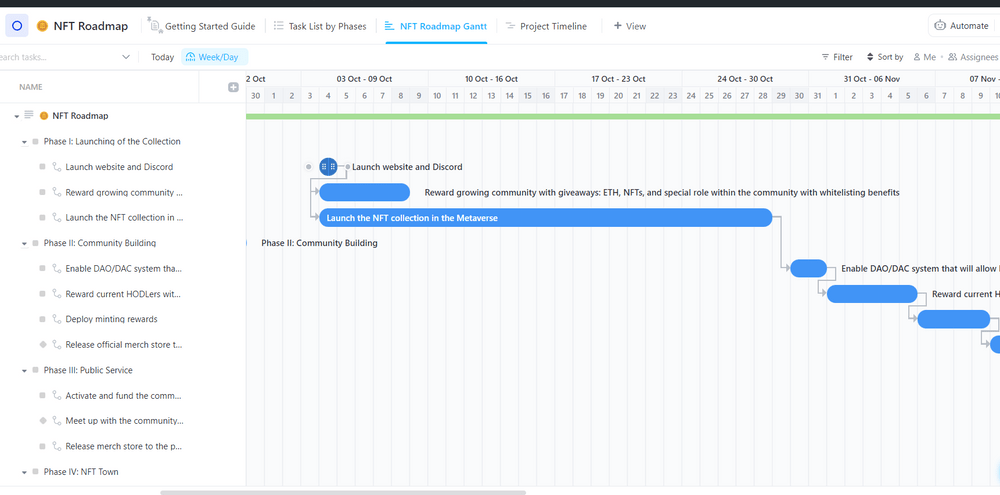
استخدم قالب عملية مبيعات ClickUp كدليل إرشادي لفريق المبيعات لديك
المقاييس الرئيسية في تخطيط المبيعات والعمليات
يمكن أن يساعد تتبع مقاييس تخطيط المبيعات والعمليات المؤسسات على تقييم الأداء, التخفيف من المخاطر والتأكد من التحسين المستمر . فيما يلي مقاييس المبيعات الرئيسية يجب عليك تتبعها لتحقيق أهداف S&OP بكفاءة أكبر:
- إجمالي المبيعات: إجمالي المبيعات في فترة محددة، سواء كانت شهرًا أو سنة أو ربع سنة
- توقعات المبيعات مقابل إجمالي المبيعات الفعلية: مبيعاتك مقارنة بالمبيعات المتوقعة للفترة المحددة
- الهامش الإجمالي: صافي المبيعات بعد طرح تكلفة السلع المباعة والخدمات المقدمة في إطار زمني محدد
- زمن الدورة الزمنية: الوقت المستغرق في إنتاج سلعة ما من البداية إلى النهاية
- معدل دوران المخزون: عدد المرات التي قمت فيها ببيع واستبدال المخزون في إطار زمني معين
- رأس المال العامل: الفرق بين أصولك المتداولة وخصومك خلال فترة زمنية محددة
- استخدام الطاقة الإنتاجية: النسبة المئوية للناتج المحتمل لعملك الذي يتم تحقيقه من الإنتاج المحتمل لعملك
- توقعات الإنتاج: توقعات عدد الأصناف النهائية التي ستحتاج إليها لتلبية توقعات المبيعات 🔮
أفضل الممارسات في تنفيذ خطة المبيعات والعمليات
الآن بعد أن أصبحت على دراية بكيفية عمل عملية تخطيط المبيعات والعمليات، حان الوقت لتتعلم كيفية تحقيق أقصى استفادة منها! دعونا نتعمق في أفضل ممارسات تخطيط المبيعات والعمليات لمساعدتك في مواءمة المبيعات والعمليات و تعزيز العمل الجماعي عبر الأقسام المختلفة.
تنفيذ الملكية التنفيذية لعمليات تخطيط المبيعات والتشغيل
يعتمد نجاح عملية تخطيط S&OP على التوجيه والإرشاد المناسبين حيث يجب على القائد خلق ديناميكية إيجابية بين الفرق التي قد يكون لديها أولويات متضاربة . على سبيل المثال، يمكن توقع حدوث بعض التوتر بين فريق العرض والطلب بسبب ضيق الوقت والقضايا المماثلة.
لهذا السبب فإن وجود ملكية واضحة لعملية تخطيط المبيعات والطلب أمر ضروري لوضع معايير للأطراف المعنية للتعاون بشكل أكثر كفاءة. يجب أن يكون هذا الشخص شخصًا ذا مكانة تنفيذية حازمة، مثل الرئيس التنفيذي أو المدير.
شجع على المشاركة متعددة الوظائف
تتطلب عملية تخطيط المبيعات والتخطيط الاستراتيجي والمشتريات مشاركة جميع الأقسام على قدم المساواة في العملية، لذا فإن التعاون متعدد الوظائف أمر حيوي لنجاحها. إذا كنت تفكر فقط في مساهمات قسم المبيعات وتتجاهل العمليات والشؤون المالية، فإن المبيعات و تخطيط العمليات لن يكون فعالاً أو منتجاً.
للتأكد من أن جميع الأطراف المعنية على اطلاع على آخر المستجدات وعلى نفس الصفحة، يجب عليك تعزيز الرؤية في جميع أنحاء مؤسستك. إحدى الطرق الرائعة للقيام بذلك هي الاعتماد على مهام ClickUp ميزة تساعدك على تخطيط وتنظيم والتعاون في أي مشروع في الوقت الفعلي. تتيح لك إدارة المهام من خلال طرق عرض متعددة مثل القائمة، ولوحة كانبان، والجدول الزمني، مما يسهل عليك معرفة المهام قيد التنفيذ أو المهملة أو التي في قائمة المهام . ✅
يمكنك مشاركة مساحة عمل ClickUp الخاصة بك مع جميع موظفيك حتى يكونوا على اطلاع دائم بأحدث التغييرات. تدعم ميزة المهام أيضًا التعاون متعدد الوظائف لأنها تتيح لك:
- إنشاء سلاسل تعليقات متعلقة بالمهام
- ذكر أعضاء الفريق الفرديين في التعليقات
- تسريع العمل الجماعي مع العديد من المكلفين بالمهام

إنشاء قوائم مهام لتتبع التقدم المحرز بسهولة في ClickUp
فهم تأثير تغيرات العرض والطلب ### فهم تأثير تغيرات العرض والطلب
نظرًا لأن تحقيق التوازن بين العرض والطلب هو جوهر عملية العرض والطلب، يجب أن تفهم التأثير الذي قد تحدثه تغييرات العرض والطلب على عملك. يمكن أن يساعدك إجراء سيناريوهات ماذا لو على فهم اتجاهات السوق بشكل أفضل ويساعدك في الاستعداد للتغيرات المحتملة في السوق
على سبيل المثال، إذا اضطررت إلى زيادة الإنتاج بسبب ارتفاع الطلب، يمكن أن تساعدك نمذجة السيناريوهات المختلفة على تحديد الفوائد طويلة الأجل ومعرفة الانتكاسات المالية قصيرة الأجل التي قد تحدث. يمكنك بعد ذلك استخدام هذه البيانات لاتخاذ قرارات مستنيرة.
استخدم الذكاء الاصطناعي والتعلم الآلي
في الماضي، كان يتم إجراء تخطيط S&OP من خلال تطبيقات وجداول بيانات منعزلة، والتي لم تكن تتيح تشغيل سيناريوهات ماذا لو، أو دعم التخطيط عبر أقسام ومواقع متعددة، أو مساعدة الشركات على الاستجابة لتغيرات السوق بسرعة.
اليوم، يعتمد المسؤولون التنفيذيون في تخطيط المبيعات والعمليات على حلول برمجية حديثة تتضمن تقنيات ذكية مثل الذكاء الاصطناعي والتعلم الآلي. يمكن لفرق تخطيط المبيعات والعمليات استخدام البيانات في الوقت الفعلي المتعلقة بتغيرات السوق و سلوك المستخدم لإدارة العرض والطلب. تدعم البرامج المصممة لهذا النوع من التخطيط أيضًا عمليات المحاكاة الافتراضية والتحليلات المتقدمة، مما يسمح للفرق بإنشاء مواقف نظرية دون اختبار خطتهم في العالم الحقيقي.
إذا كنت تبحث عن أداة ذكاء اصطناعي سهلة الاستخدام, ClickUp Brain سيكون أفضل صديق لك! 🧑🏼🤝🧑🏻
يمكن أن تكون هذه الأداة بمثابة مدير مشروع الذكاء الاصطناعي الذي يساعدك على أتمتة عملك وتحديثات الفريق والتقارير المرحلية والوقوف الفردي. يمكنك أيضًا طرح أي أسئلة والحصول على إجابات سياقية من مستنداتك ومهامك ومشاريعك أو استخدامها لـ إنشاء رسائل بريد إلكتروني للحصول على ردود سريعة ومتسقة.

استخدم ClickUp AI لتسريع عملية S&OP من خلال إنشاء رسائل البريد الإلكتروني وأتمتة المهام
احتفظ بالسجلات
التعلم من أخطاء الماضي يدفع التقدم في عملية تخطيط المبيعات والخطط، لذا فإن الاحتفاظ بسجلات مفصلة لخططك السابقة أمر بالغ الأهمية. قم بتوثيق أكبر عدد ممكن من جوانب جهود تخطيط المبيعات والعمليات الخاصة بك حتى تتمكن من الرجوع إلى ملاحظاتك مع تطور السوق وتحديد الخطط والعمليات التي نجحت في الماضي والتي لم تنجح في الماضي ولماذا. يمكنك تحديد الخطة الأفضل لأعمالك وتعديل استراتيجياتك الحالية وفقًا لذلك.
أفضل أداة للاحتفاظ بسجلات لمبيعاتك وخطط عملياتك هي مستندات ClickUp -تتيح لك المستندات القابلة للتخصيص بالكامل إضافة صفحات وصفحات فرعية وجداول وصور لتناسب احتياجات عملك بشكل مثالي! ✨
المستندات أيضًا تدعم التعاون من خلال السماح بالتحرير والتعليق في الوقت الفعلي داخل المستند. بالإضافة إلى ذلك، فهو يتضمن التحكم في الأذونات، بحيث يمكنك الحفاظ على خصوصية عمليات تخطيط المبيعات والعمليات السابقة الخاصة بك وتوفير الوصول لأعضاء الفريق المعنيين فقط.
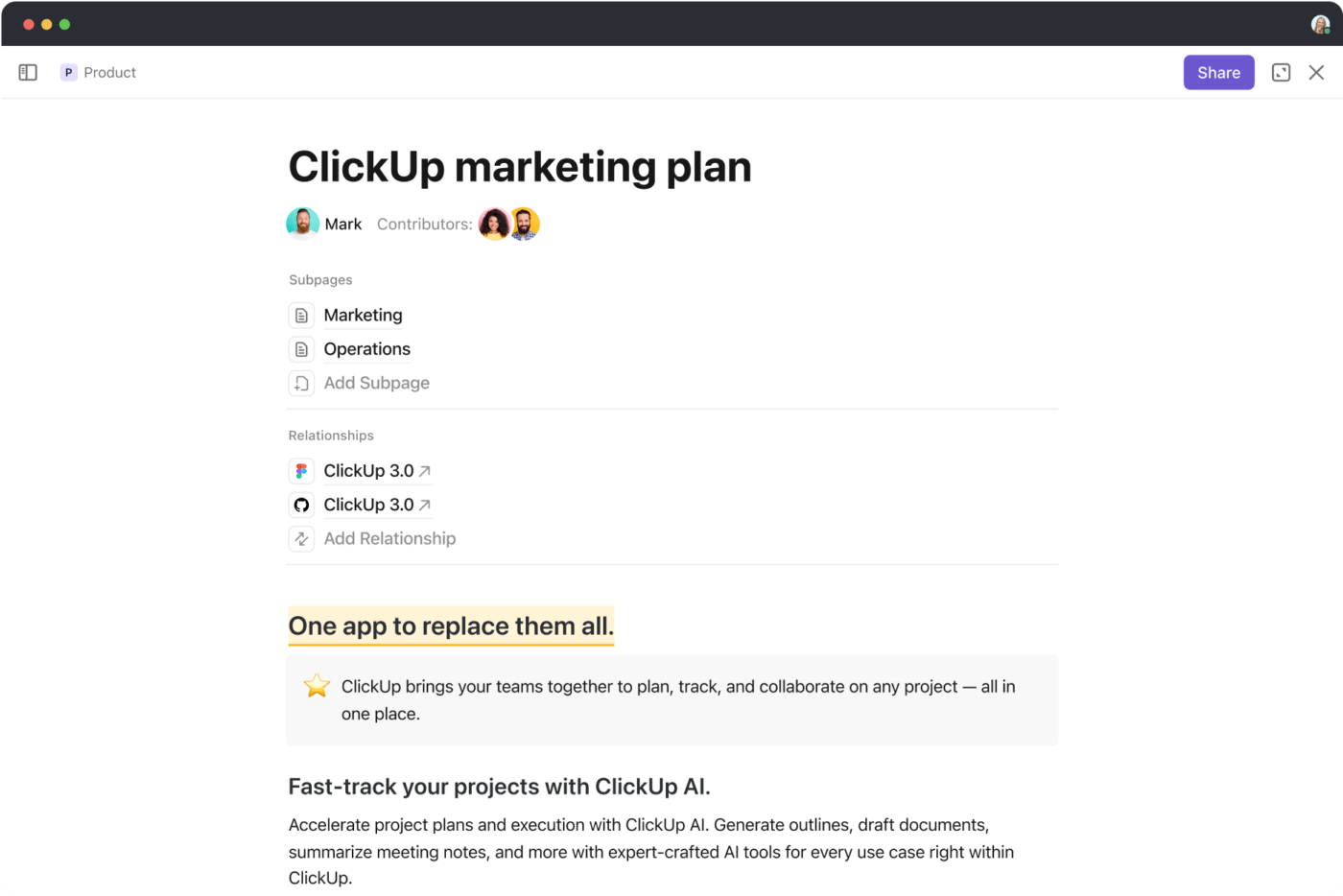
حافظ على تنظيم جميع مستنداتك وسهولة الوصول إليها من قبل الفريق بأكمله مع ClickUp
استخدم أداة CRM
يمكن أن تساعدك إضافة أداة إدارة علاقات العملاء (CRM) إلى مجموعة أدوات إدارة علاقات العملاء (CRM) في مجموعة أدوات S&OP الخاصة بك على زيادة دقة التوقعات التشغيلية. توفر أداة فعالة لإدارة علاقات العملاء (CRM) رؤى حول الوقت المتوقع لحدوث الطلب على المنتج ويمكن أن تشير إلى العملاء المتوقع أن يؤثروا على حجم الإنتاج. وبهذه الطريقة، يمكنك التأكد من أن قرارات سلسلة التوريد تستند إلى تقييم الطلب الأكثر دقة. أدوات إدارة علاقات العملاء تساعدك على إنشاء رؤية شاملة لعملائك، مع التركيز على تفاعلاتهم مع شركتك وإيجاد المعلومات اللازمة لتحسين التواصل مع العملاء. يمكنك تعميق علاقتك مع عملائك والتحكم في اكتساب العملاء والاحتفاظ بهم. تحسين إدارة علاقات العملاء بالاعتماد على ClickUp CRM -أفضل حل لإدارة علاقات العملاء في السوق! فهو يتيح لك تصور جميع بيانات عملائك في مكان واحد من خلال أكثر من 50 بطاقة لوحة تحكم، بما في ذلك الرسوم البيانية الدائرية أو الخطية أو الشريطية. 📊
قم بإدارة مشاركة عملائك وخطوط المبيعات والطلبات باستخدام عروض متعددة للمشاريع مثل لوحة كانبان أو القائمة أو عرض الجدول، والتي تتيح لك
- تنظيم العملاء في مجلدات
- تتبع الطلبات من خلال الحقول المخصصة
- حساب الإيرادات باستخدام الحقول الرقمية
- إدارة مبيعاتك وخط أنابيب الحساب من خلال الحالات المخصصة
- تعيين ترتيب واضح للعمليات باستخدام تبعيات المهام

تتبع مسار المبيعات وتفاعلات العملاء باستخدام طرق العرض المخصصة في ClickUp
يمكنك أيضًا أتمتة عملية البيع الخاصة بك باستخدام انقر فوق المبيعات ميزة. إنها تتيح لك تتبع مسار المبيعات بالكامل وتساعدك على إبقاء العملاء المحتملين يتحركون عبر خط سير المبيعات من خلال تعيين المهام تلقائيًا في كل مرحلة من مراحل العملية.
عزز كفاءة S&OP باستخدام ClickUp
يمكن أن يساعد تنفيذ خطة المبيعات والتشغيل بشكل صحيح في زيادة إيرادات عملك، وتقليل تكاليف الإنتاج، والحفاظ على رضا عملائك. لتبسيط تنفيذ عملية تخطيط المبيعات والتشغيل S&OP, اشترك في ClickUp مجانًا واستمتع بمجموعة واسعة من أدوات إدارة علاقات العملاء, نماذج خطط المبيعات المصممة مسبقًا وميزات قوية لإدارة المشاريع - كلها مصممة لمساعدة عملك على الازدهار! 🙌

